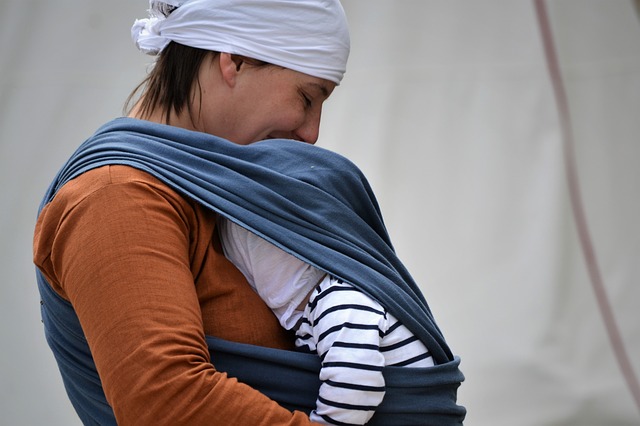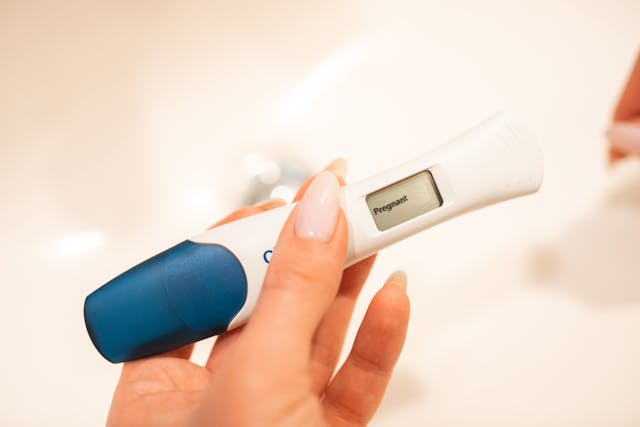The range of baby-carriers and slings available to parents can be a daunting choice! Choosing the right one for you can be tricky, and your preference may change as your child gets older. I’ve owned almost every type of carrier at one point or another, trying to find the one that suits me and my daughter. And over time I’ve found our needs changing, so I’ve had to try new slings.
From wraps and ring slings; soft-structured carriers and mass-produced carriers, to Mei Tais and Podaegis; there is a plethora of choice. And that doesn’t even cover all the different brands out there! So here is my guide to choosing the right carrier for you.
Ring-slings and Pouches
1 – Ring SlingA ring sling is made of a long piece of material that threads through a pair of steel rings to form a pocket for the baby with a long tail that hangs down your body.
A pouch is similar, except is made from one piece of material that forms a sort of tube, creating a pocket for your baby to lay or sit in. Both carriers can be used with newborns through to toddlers, making them a good choice for a first-time sling.
Advantages:
- Cheaper than other slings
- Reduce down to a very small size for ease of storage
- Can be used from newborn to toddler
- Quick and easy to get on
- Very easy for a beginner to master 2 – Pouch
- Ring-slings come in some beautiful colours and patterns
- Ring-slings can utilise a number of different carries, i.e. back carry, hip carry, front carry
Disadvantages:
- The weight is distributed on one shoulder only, which can be a problem with older babies and toddlers
- Ring-slings can be tricky to adjust to a comfortable position
- Pouches have to be made to fit the wearer, so are unlikely to fit a partner or other person
Woven and stretchy wraps
A wrap is basically a long piece of material specifically woven for the purpose of carrying a baby. There are a number of different ways to tie the material to carry a baby, from cradle-type carries, to front carries, back carries and hip carries.
Stretchy wraps are easier to tie, as they have some ‘give’, but can become uncomfortable as a baby gets older. Woven wraps are trickier to master, but are more comfortable and supportive as a baby grows. Both wraps can be used with newborns through to toddlers, depending on the carry being used.
Advantages:
- Can be used with newborns through to toddlers 3 -Stretchy Wrap
- The material can be ‘up-cycled’ once it is no longer needed to carry a baby
- Very versatile, allowing a number of different carries
- Can be used with multiple wearers
- Comfortable to use for long periods
- Come in beautiful styles, patterns and colours
Disadvantages:
- Wraps can be very expensive compared to other carriers, although they do have a good re-sale value
- Tying a wrap can be tricky to master, and takes lots of practice to get the carries correct
- Fastening a wrap takes time and so can be difficult with an energetic toddler who is impatient
- Lengths of fabric trail on the ground while the wrap is being tied, so it’s not so good for fastening in poor weather
Mei Tais
4 – Mei TaiMei Tais are a traditional style of Asian carrier consisting of a shaped piece of fabric with long straps at the base and top. The shaped fabric fits around the baby’s body; the bottom straps tie around the wearer’s waist, and the top straps cross over the wearer’s shoulders, under the baby’s bottom, and tie around the waist.
Mei Tais come in a variety of shapes, styles and colours; and some have extra features such as sleeping hoods. They are suitable from babies with good head control up to toddlers.
Advantages:
- Can be used for a variety of carries: hip, front or back
- Very comfortable for long periods and with heavy babies
- Will fit different adults with no adjustments
- Come in a range of styles and colours
- Simple and relatively quick to tie with practice
- Have a varied price-range, with simple cheaper versions, and more lavish, expensive versions
Disadvantages:
- The long straps trail on the floor during fastening
- Not suitable for use with newborns, so a different carrier would need to be used until baby has head control
Podaegis and Other Torso Carriers
Torso carriers, such as Podaegis and African-style carriers are typically made from a long length of padded fabric, sometimes with tails. They are designed primarily for back carries and wrap around the wearer’s torso, forming a pouch for the baby, and tie over the breasts. They come in a range of patterns and colours, and are comfortable for long periods and with heavier babies and toddlers.
Similar to Mei Tais, torso carriers are for babies who have good head control.
5 – PodaegiAdvantages:
- Comfortable for long periods and with heavier babies
- Come in a range of patterns and colours
- Simple to master with practice
- Will fit different adults without adjustment
Disadvantages:
- Primarily designed for back carries, although other carries can be used with practice
- This carrier is less popular and well-known, so more difficult to get hold of and more expensive
- Can be difficult to fasten with an active baby
- Unsuitable for use with newborns
Soft-structured Carriers
These carriers are structured and padded, fastening with straps and buckles, and designed to distribute the weight of the baby. They can be used on the wearer’s back or front, and are comfortable for long periods and with heavy toddlers. Soft-structured carriers come in a wide range of brands, each with their own style, shape and unique features, such as sleeping hoods, storage pockets and covers.
6 – Soft-structured CarriersAdvantages:
- Comfortable for long-term wear and with heavier babies and toddlers
- Come in a wide range of styles, colours and patterns
- Come in a wide range of prices, from simple, cheaper carriers, to more expensive ones
- Quick and easy to put on with little practice, so ideal for active toddlers
- Fold up into a small bag
Disadvantages:
- Need adjustment for each different wearer
- Unsuitable for babies under three months old
- Can only be used for front carries or back carries
A Note About Mass-produced carriers
Most baby companies stock their own brand of mass-produced carrier. These carriers are cheap, widely available and unfortunately popular. I bought one myself when I was expecting.
The problem with most mass-produced carriers is the way the baby is held, often with a thin piece of fabric between the legs. There is some evidence that these carriers put pressure on a baby’s developing spine and hips and can cause problems, especially if the baby faces outwards.
Unlike soft-structured carriers, which carry baby in a froggy-style with the legs held above the bottom; mass-produced carriers often have the baby’s legs dangling down straight. This type of carrier also puts pressure on the wearer’s back and shoulders and is very uncomfortable for long-term use. They are also often difficult to adjust and get a baby into without assistance.
For more information on baby-wearing, specifically with regard to infant spine development and the problems caused by some types of carrier, I highly recommend reading this article.
About the Author:



We love our Baby Hawk Mei Tei! It takes off a lot of the weight from my shoulders and redistributes it along my back. I, too, bought a mass produced carrier with my first baby and couldn’t even walk with it on. It cut into my shoulders so deeply and it was so uncomfortable for both of us. Great article!